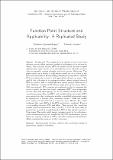Mostrar el registro sencillo del ítem
Function Point Structure and Applicability: A Replicated Study
| dc.creator | Quesada López, Christian Ulises | |
| dc.creator | Jenkins Coronas, Marcelo | |
| dc.date.accessioned | 2018-01-19T14:44:00Z | |
| dc.date.available | 2018-01-19T14:44:00Z | |
| dc.date.issued | 2016 | |
| dc.identifier.citation | http://www.jot.fm/contents/issue_2016_03/article2.html | |
| dc.identifier.issn | 1660-1769 | |
| dc.identifier.uri | https://hdl.handle.net/10669/73892 | |
| dc.description.abstract | The complexity of providing accurate functional software size and effort prediction models is well known in the software industry. Function point analysis (FPA) is currently one of the most accepted software functional size metrics in the industry, but it is hardly automatable and generally requires a lengthy and costly process. Objectives: This paper reports on a family of replications carried out on a subset of the International Software Benchmarking Standards Group dataset (ISBSG R12) to evaluate the structure and applicability of function points. The goal of this replication is to aggregate evidence about internal issues of FPA as a metric, and to confirm previous results using a different set of data. Methods: A subset of 202 business application projects from 2005 to 2011 was analyzed. FPA counting was analyzed in order to determine the extent to which the basic functional components (BFC) were independent of each other and thus appropriate for an additive model of size. The correlations among effort and BFCs and unadjusted function points (UFP) were assessed in order to determine whether a simplified sizing metric might be appropriate to simplify effort prediction models. Prediction models were constructed and evaluated in terms of accuracy. Results: The results confirmed that some BFCs of the FPA method are correlated. There is a relationship between BFCs and effort. That suggest that prediction models based on transactional functions (TF) or external inputs (EI) appears to be as good as a model based on UFP in this subset of projects. Conclusions: The results might suggest an improvement in the performance of the measurement process. Simplifying the FPA measurement process based on counting a subset of BFCs could allow savings in measurement effort, preserving the accuracy of effort estimates. | es_ES |
| dc.description.sponsorship | Universidad de Costa Rica/[834-B5-A18]/UCR/Costa Rica | es_ES |
| dc.language.iso | en_US | es_ES |
| dc.source | Journal of Object Technology; Volume 15, Numero 3. 2016 | es_ES |
| dc.subject | Function point analysis | es_ES |
| dc.subject | Software effort prediction | es_ES |
| dc.subject | Family of replications | es_ES |
| dc.subject | Empirical evaluation | es_ES |
| dc.title | Function Point Structure and Applicability: A Replicated Study | es_ES |
| dc.type | artículo original | |
| dc.identifier.doi | 10.5381/jot.2016.15.3.a2 | |
| dc.description.procedence | UCR::Vicerrectoría de Investigación::Unidades de Investigación::Ingeniería::Centro de Investigaciones en Tecnologías de Información y Comunicación (CITIC) | es_ES |
| dc.identifier.codproyecto | 834-B5-A18 |


